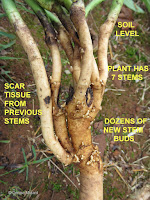MILKWEED COMPARISONS
Here are some comparisons between Swamp Milkweed, Butterfly Milkweed and Common Milkweed.
For MILKWEED TOXICITY please go to the bottom of this page.
PLANT HEIGHT AND SHAPE:
Swamp Milkweed can reach a height of around 150 cm (5 ft.), whereas Butterfly Milkweed is shorter, up to one meter (3 ft.) high. Swamp Milkweed stems grow from a clump that gets larger every year, and those stems open up fan-like. Butterfly Milkweed stems are vertical and there may be a few emerging from one single root. Common Milkweed can reach heights of 2.6 meters (8 ft.), and the stems grow straight up from rhizomes.
 |
| Swamp milkweed grows from a clump, opens up fan-like |
 |
| Butterfly milkweed grows straight from individual stems |
 |
| Common milkweed is taller, establishes colonies from its rhizomes |
THE SHOOTS:
Right from the start when they come up in the spring, these three milkweed species look different. Here are photos of their shoots in early June (the last one to show up is the Butterfly Milkweed on Prince Edward Island, Canadian hardiness zones 5a-5b):
 |
| Swamp milkweed shoots, reddish and glabrous stems |
 |
| Butterfly milkweed shoots, green and hairy stems |
 |
| Common milkweed shoots, glabrous and green stems, not in clumps |
Swamp Milkweed flowers appear as clusters at the top of the stems. They are usually pink, sometimes white. Butterfly Milkweed flowers also appear as clusters at the top of the stems, but the clusters are flatter. The blooms are usually orange, sometimes yellow. Common Milkweed flowers bloom alongside the stems near the top, and as pink clusters.
 |
| Swamp milkweed flowers, pink |
 |
| White Swamp milkweed flowers |
 |
| Orange Butterfly milkweed flowers |
 |
| Orange and yellow Butterfly milkweed flowers |
 |
| Pink Common milkweed flowers, photo by James Steakley |
THE LEAVES:
Swamp and Butterfly milkweeds have narrow and pointed leaves. Butterfly Milkweed leaves are slightly smaller and darker than Swamp Milkweed leaves, and are hairy while Swamp Milkweed leaves are glabrous. Common Milkweed leaves are longer and larger, and their tip is more round. The vein pattern of the three species is also different.
 |
| Butterfly and Swamp milkweed leaves |
 |
| Common milkweed leaves, photo by Cbaile19 |
THE PODS AND SEEDS:
Swamp Milkweed pods are mostly still green when their seeds are ripe. They contain roughly 65-70 seeds. Most of the pods ripen about a month before the Butterfly Milkweed ones, from the end of September on Prince Edward Island.
The Butterfly Milkweed pods are longer, purple and hairy, and they ripen from the end of October on PEI. The pods contain around 80-90 seeds.
Common Milkweed pods are more plump and light green when still unripe, with soft spikes.
The pods of those three species split longitudinally when their seeds are ripe, and each seed has a small silky parachute to facilitate its spread.
The seeds of the three species are similar in shape, but the Swamp Milkweed seeds are lighter brown and larger than the Butterfly Milkweed seeds. However, the parachutes of the latter have longer silks than the former.
 |
| Swamp milkweed ripe seedpods, but still green |
 |
| Butterfly milkweed unripe seedpods, with two ripe Swamp milkweed seedpods |
 |
| Unripe Common milkweed seedpod, plump with soft spikes, photo by H.Zell. |
 |
| Swamp and Butterfly milkweed seedpods |
 |
| Swamp and Butterfly milkweed pods and seeds |
 |
| Swamp and Butterfly milkweed seeds |
Common milkweed seeds with their parachutes, photo by Kingturtle
THE ROOT SYSTEM
Swamp Milkweed forms a clump of roots, which are white and fleshy. The future stems grow from buds at the base of the plant, so that one plant clump has many stems after a few years. This makes it easy to transplant even when the clump is large.
Butterfly Milkweed grows a fibrous tap root which can reach up to 60 cm long (2 ft.) The future stems grow from buds around the tap root near the top, but underground. The tap root makes this species difficult to transplant.
Common Milkweed grows horizontal rhizomes that can extend several feet (meters), and stem buds start along those rhizomes. Thus one single plant can cover a large space, forming colonies.
 |
| Swamp milkweed white fleshy roots |
 |
| Swamp and Butterfly milkweed roots |
 |
| Old Butterfly Milkweed root |
 |
| Common milkweed long roots, photo by Michelle Clay |
 |
| Common milkweed rhizomes with stem buds, photo by Michelle Clay |
MILKWEED TOXICITY:
Here are the levels of toxicity of the three milkweed species described here:
Swamp Milkweed : high
Common Milkweed : moderate
Butterfly Milkweed: low
This information on milkweed toxicity is drawn from the following source: https://monarchwatch.org/bring-back-the-monarchs/milkweed/milkweed-profiles/.
Many wild plants such as milkweed are eaten by humans as part of a more natural diet, however precautions need to be taken in the food preparation.
There is information available online and in books about how to prepare milkweed, on which species can be eaten, which part and at which stage.
On the other hand, other online sources do NOT recommend eating any milkweed.
